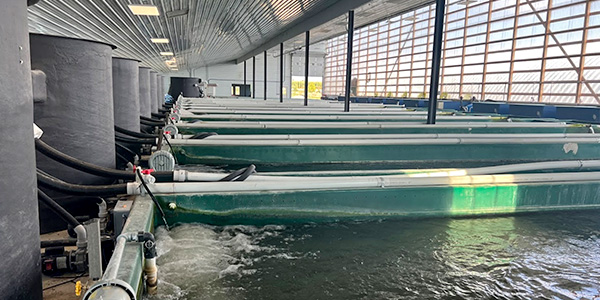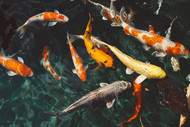Koi Winter Care Guide - Winterize Your Koi Pond
6th Apr 2023
Koi fish have long been one of the most sought-after pets due to their beauty and interaction with humans. However, it is critical that you know how to care for them to help them live a long and happy life. Hibernation is one of the key elements of the Koi’s longevity, therefore, it is critical to know how to winterize a koi fish pond properly. In this article, we will go over the ways to properly winterize your Koi pond to provide your fish with a healthy environment for hibernation.
How To Care for your Koi in the Winter
There are a few different ways to care for your koi in the winter, such as bringing them inside, using a de-icer, or even heating the pond. Let’s go over a few of these in more detail below:
Move the Koi to an Indoor Pond
Setting up a tank in the house or garage could help keep your Koi warm during the winter months. Although this is a more expensive option, this is a great way to keep your koi safe during winter. This often involved pouring masonry inside your home, with the pumps connected to your utility room. It’s also recommended to add lighting to your indoor Koi pond. Indoor Koi ponds are usually 4,000 gallons maximum, which will provide your Koi with enough room to move around.
Place a De-Icer and Stone in the Pond
A pond de-icer or a heater is another great way to keep your Koi pond warm during the winter months. It is critical to leave a breathing hole in the pond for purposes of gas exchange. CO2 needs to be released from the pond, no matter how well you’ve cleaned it, as small amounts of waste are most likely still present at the bottom. This prevents the buildup of ammonia, which can cause imminent harm to your Koi.
Do These Things If You’re Shutting Down The Pond for Winter
If you plan on shutting down your pond for the winter, there are a few things you need to do first. These steps are important to ensuring that your Koi are comfortable and safe during the winter. Let’s check out the process in more detail below.
Install Pond Netting
Installing pond netting is a great way to avoid fallen leaves entering the Koi’s habitat. Once the leaves are done falling, just roll up the net until next time.
Remove Debris
In the event that leaves and other debris enter the pond, you should remove any debris immediately to keep the habitat healthy for your Koi. A long-handled pond net would be useful to easily remove any debris from your pond.
Keep the Skimmer Basket Clean
Keeping the skimmer basket clean is a great way to maintain your pond. We recommend checking the skimmer basket every few days to ensure it is not filled with leaves and other debris.
Trim Dead Foliage
Keeping your pond clear of dead or dying organic debris prevents them from decomposing in the water. Marginal plants can be left in the pond, while tropical plants should be removed.
Prepare Water Lilies for Winter
Water Lilies should be cut two inches above the crown. They should then be moved to a deeper part of the pond which is at least two feet in depth. It’s possible to bring them inside and use a grow light to keep them over the winter, however, there’s no guarantee they will last all throughout the winter months.
Add Cold Water Bacteria
Although keeping your pond clean can be difficult during the winter, cold water bacteria can help keep the water clean and clear. This bacteria includes beneficial bacteria that goes to work in temperatures less than 32 degrees Fahrenheit. Using cold water bacteria will keep your water clear, and make it easier to maintain in the Spring.
Leaving Your Pond Running
There is always the option to keep your pond running throughout the winter months, however, it is important to keep in mind that this will require regular maintenance. This includes topping off the pond, and ensuring that the ice formations do not create dams, leading to water loss. During an intense cold, the surface of the pond water will likely freeze over. Therefore, it is critical to use an aerator or in-pond pump. Adding a pond de-icer could also be an option if you live in a particularly cold climate.
Shutting Down Your Pond
If you live in an extremely cold climate, you might choose to shut down your pond for the winter. If you do choose to shut down your pond, you should do the following:
- Take the pump out of the pond and make sure you store it in a warm area for the winter. Keeping it away from the cold will increase its lifespan.
- Standing water could freeze and crack the pipes on your filtration system. Therefore, it is best to ensure that you drain the water to prevent it from freezing.
- Clean and remove the filter and ensure they are stored in a warm place with the pump.
- Use a small recirculating pump on the top shelf of the pond. This both helps keep a hole in the ice, and also keeps oxygen circulating throughout the pond. The hole in the top of the pond allows the gasses to leave, and oxygen to enter.
- If you live in a colder climate, a de-icer would be a good option.
Keep The Fish Healthy Before Winter
Before winter comes along, it’s critical to ensure your fish are healthy before they begin to hibernate. As the temperature begins to drop and the water temperature decreases to below 60 degrees, your Koi’s metabolism and digestion slows. Therefore, it is important that they are fed a healthy and balanced diet to ensure they will be healthy throughout the winter months.
How To Winterize The Pond Instead
If you want to winterize your pond instead, there are a few different ways to do this. This includes building a greenhouse to cover your pond, adding cold water bacteria, and oxygenation, and keeping the pond clean of dirt or debris. Let’s go over each one in more detail below.
Build a Greenhouse to Cover Your Pond
Covering your koi pond in the winter can be a great way to keep it safe. You can do this by buying a small greenhouse kit, or putting together a DIY one using PVC or wood and a plastic sheet. You can even install a heater in the pond to grow your Koi similar to how you would in the summer.
You should cover the frame of the pond and place weights or heavy objects surrounding the outside. With the right construction, you can keep the warm air inside the greenhouse to keep your koi warm and happy.
Consider Oxygenation
Use a small recirculating pump on the top shelf of your pond. This helps keep oxygen inside the pond and ensures that a hole remains open when the pond begins to freeze.
Clean The Pond For Leaves and Debris
Keeping the pond clean is critical, especially if you plan on keeping the pond open throughout the winter. This will keep the fish happy and healthy and make it easier to clean the pond in the Spring.
Additional Koi Winter Care Tips
There are a few different ways to care for your Koi fish during the winter months. Changing things like the type of food you give them and what to watch out for are crucial to their health and longevity. Let’s check this out in more detail below:
- You should stop feeding your Koi when the water temperature goes below 55 degrees.
- Remove your autodoser if you have one, and keep it in a warm, dry place until Spring.
- To help keep your Koi pond clear, beneficial bacteria can be used. When the water temperature dips below 55 degrees, it is recommended to use cold water bacteria.
- Check your pond for any ice dam formations, as this could cause water to leave the pond, especially if you have your pump running.
- To make sure that your fish are safe, place plant cover around your pond. This will protect them from any potential predators.
- If you lose track of time, and your pond freezes over before it’s winterized, be sure to make a small hole in the ice so oxygen can enter the pond, and CO2 can exit. However, never, hit the ice with a hammer or blunt object in an attempt to break the ice.
Frequently Asked Questions
Can koi fish live in the winter?
Yes, koi fish live in the winter. Koi fish need plenty of oxygen to live in the winter. It is a good idea to monitor ammonia in pond water through the winter months. Water quality is very important for koi to live in the winter, just as important as during the summer months.
How do you keep koi alive in the winter?
It is very important to provide adequate oxygen to keep koi alive in the winter. Koi generally remain near the pond bottom during the winter months. Pond water is generally warmest in the deeper areas. Another tip to keep Koi alive in the winter is to refrain from feeding commercial pellets to give their digestive system a rest and keep it healthy.
How do you prepare a koi pond for winter?
The best way to prepare a koi pond for winter is to perform a fall cleaning before winter sets in and water temperature drops dramatically. Remove sludge, leaves and debris from pond bottom. Keeping the pond bottom clean will help with parasite control, as many parasites thrive in layers of pond muck.
Do koi need to hibernate?
Koi do not need to hibernate but their reproductive systems need a resting period to regenerate and prepare for the spring time spawn. When koi fish hibernate, they are in a state of torpor. This allows the koi to slow their metabolism, breathing and body temperature to survive the winter months.
Is a frozen pond dangerous for koi?
A frozen pond can be very dangerous for koi, especially if the surface remains frozen for a long period of time. The ice-cap will trap gasses in pond water and also reduce oxygen in-take. If the pond is frozen for a short period of time the oxygen level may be adequate to sustain your koi. Cool water holds more oxygen than warm water.
How deep should a koi pond be for winter?
Depth of a koi pond for over wintering koi fish varies. Generally, a koi pond should be 24-36” deep for koi to survive the winter months. In cold climates where ponds water can freeze and ice may become very thick, a 3–4-foot depth or more is recommended. Always provide aeration for your koi pond in winter.
Do koi fish eat in the winter?
In nature a koi fish will eat some animal and plant life during the winter. However, when koi are in the state of torpor they generally do not eat. When the pond temperature rises to above 50 degrees F koi may nibble on algae along pond sides in winter though generally will not come to the pond surface looking for food.
Do koi grow in the winter?
Some koi grow during the winter, though not as much as during the warmer months. Their slowed metabolism reduces growth rates in cold water. Koi growth in the winter depends on the nutrients and stored fat in their bodies.


